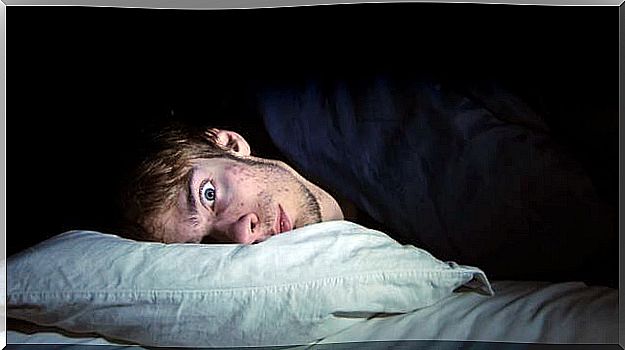Sleepwalking: When The Body Acts While We Sleep

Sleepwalking is a relatively common phenomenon, especially in children. It is defined as a sleep disorder in which a person wanders while asleep. Or, in other words, sleepwalking is someone who gets out of bed and shows motor activity during sleep without awareness or control of said activity.
Sleepwalking is known to many because it has been caricatured in comic strips and movies, depicting people walking in their sleep, arms extended forward. The myth that waking up a sleepwalker is dangerous has also become popular . In reality this is not the case, but as it is an enigmatic behavior it has given rise to various legends and fictions.
Sleepwalking is not a disease , nor is it a deficiency, nor is it an incomprehensible rarity. Although science has not been able to fully explain it, it is known that this behavior does not pose a danger in itself. Whats the matter, then? Why do some people present it and others don’t? Is there any way to treat it? These are the questions that we will address next.
Manifestations of sleepwalking
As stated earlier, sleepwalking has two characteristic features:
- It occurs when a person is asleep.
- It implies a motor activity.

This last statement is where the most misunderstandings arise: not all sleepwalkers sleepwalk. To clarify this point, let’s look at some of the main manifestations of sleepwalking:
- Sit up and sit on the bed.
- Do a mime while you are asleep. For example, that you wear your shoes, or that you dress.
- Get out of bed with your eyes open and “look” at various points, without being aware of what you are seeing.
- Talk, saying words that make little sense.
- Sleepwalking, wandering aimlessly, or performing an automatic activity such as opening the refrigerator door.
In most cases, the sleepwalker only sits on the bed. The episodes in which he gets up are rarer and those in which he leaves his house or performs more complex actions are much rarer. The sleepwalker hardly ever remembers anything that has happened.
The causes of sleepwalking
Where does this enigmatic behavior come from? Science does not yet have a definitive answer, but several possible explanations have emerged, some of them really fascinating. Practically all the hypotheses associate sleepwalking with episodes of anxiety.

It is important to note that sleepwalking occurs more frequently in children under 15 years of age. Therefore, one of the first hypotheses aimed to define it as a manifestation of the maturation process of the central nervous system. That is why many children sleepwalking when they grow up, completely spontaneously.
However, recent research, developed by Stanford University, reached different conclusions. The experts observed some animal behaviors, such as frigates, which fly in their sleep. They then deduced that sleepwalking came from an archaic region of the brain. Digging deeper, they established a connection between alertness and sleepwalking episodes.
They indicated that during sleep the brain maintains one of its hemispheres in an “alert state.” It is a basic defense mechanism. If, for example, a fire starts, we will wake up even though we are sound asleep. In the sleepwalker there is an anomaly of that alert. He cannot go from sleep to wakefulness at all. Your alert motor mechanisms are activated, but not your consciousness. That is why it is said that it is intimately linked with anguish, which in turn is fear without the presence of real danger.
The risks of sleepwalking
Although sleepwalking is not dangerous in itself, as noted above, it can eventually be problematic. In principle, cases in which the person gets out of bed and walks in sleep can lead to accidents: trips, falls or come into contact with dangerous substances. The sleepwalker can also open the gas tap or touch a faulty switch, for example. In that sense, there are risks.

There have also been cases that go further. For example, in 2009 an English teenager got up from her bed and jumped out of the window, 8 meters high. It is worth noting that sometimes sleepwalkers leave their homes and face the dangers of being on the street without awareness of their actions.
One of the most high-profile cases was that of Kenneth Parks, in Toronto (Canada). It happened in 1987 and had fatal consequences. This man woke up asleep, got into his car and drove 23 kilometers. Later, he murdered his father-in-law. There was no reasonable reason for him to have done this, but it did. Due to his state of unconsciousness, he was exonerated in court.
What to do in the face of those who walk in sleep?
Cases in which sleepwalking goes beyond sitting up in bed or walking a few feet are extremely rare. The episodes usually last between 30 seconds and 10 minutes. On rare occasions it exceeds that time, but it is known that it can go up to 30 minutes. In principle, what should be done is to take some preventive measures :
- Do not dine very late, or in a very abundant way.
- Do not engage in highly stimulating intellectual or physical activities shortly before bedtime.
- Calm yourself before going to sleep, especially if you’ve had an upset or great concern.
- Take a warm bath and do a relaxing reading before going to bed.
- Do not drink alcohol or psychoactive substances before sleeping.
If sleepwalking is usually accompanied by walks around the house, it is best to remove obstacles to avoid tripping. If there are stairs, put a barrier on them. Also, secure doors and windows to prevent the sleepwalker from leaving without others noticing.

Sleepwalking is associated with anxiety, so the most important thing is to work on those concerns that are at the base of everything. Meditation or relaxing walks are highly recommended. A psychological therapy can also be very suitable to overcome sleepwalking episodes.









